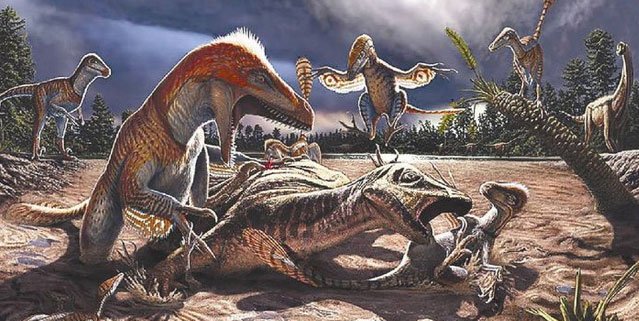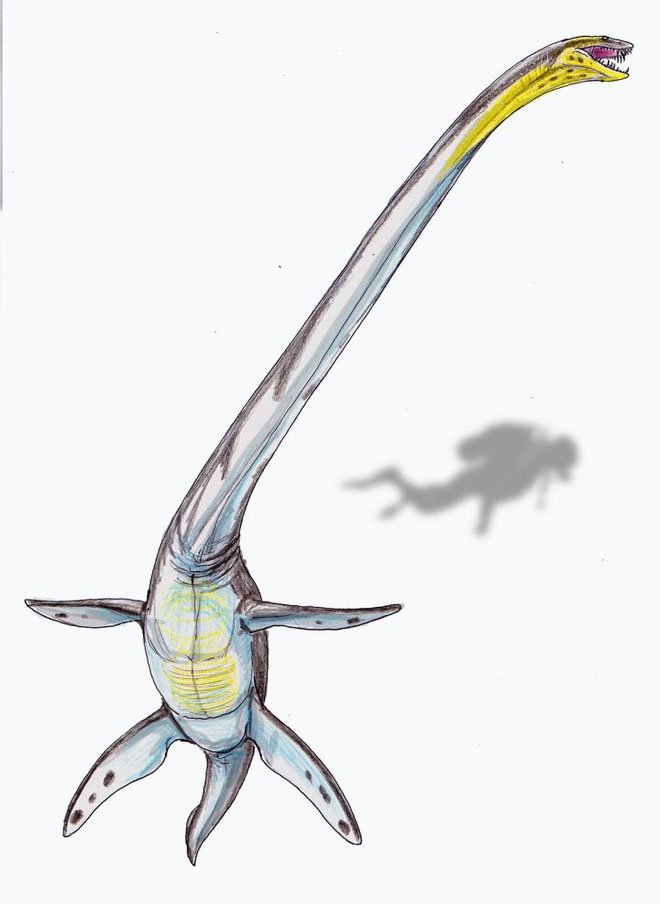Prehistoric snake neck lizards have similar diving abilities to modern sperm whales
Snake neck lizard is a large extinct marine reptilian genus of the Plesiosauria . The first specimen was discovered by Mary Anning between 1820-1821 but lacked a skull.
Plesiosaur once ruled the ocean for over a hundred million years before disappearing at the same time as the dinosaurs went extinct. Despite the widespread popularity of prehistoric oceans, its presence is tied to many questions about biological, anatomical and evolutionary characteristics that researchers have not been able to answer. Plesiosaurs are very strange animals, according to Dr. Ketchum, who looks after the geological samples at the museum. "They are related to other reptiles such as dinosaurs, crocodiles, fish lizards and turtles, but we are not sure how to classify them , " Dr. Ketchum said.
Snake neck lizard or Plesiosaur is an extremely famous family of sea reptiles in the Mesozoic (Mesozoic). Recent studies show that they have very large red blood cells, so they can dive much deeper into the ocean than we have known before.

Plesiosaur is related to other reptiles such as dinosaurs, crocodiles, lizards .
In the Mesozoic era, from 250 to 660 million years ago, our Earth existed a large number of reptiles living in the ocean, including snakes of ancient snakes.
The last Plesiosaurs survived at the same time as the dinosaurs, and they chose to follow an evolutionary path to have a long neck and a good example is the Elasmosaurus .

Elasmosaurus is one of the earliest and most famous snake neck lizards that lived in North America at the end of the Cretaceous more than 80 million years ago. They have a neck that accounts for more than 50% of their body length (7 m compared to a body length of more than 10 m). The incredible long neck of this Elasmosaurus sea lizard led to an interesting theory in the 1930s when it was thought that the mysterious Loch Ness monster was actually an un extinct Elasmosaurus. In fact, because of the length of the neck and the huge size of the body, this sea lizard cannot stand up like a swan, or even in a picture of the famous Loch Ness monster.
In addition to being able to observe direct changes in appearance, the researchers tried to explore the evolutionary path of the ancient snake lizard species from a micro perspective. Zoologist Kai R. Caspar of the University of Berne and other paleontological researchers have discovered that the Plesiosaurs eventually have red blood cells much larger than those of ancient snakes. ever existed before.
And this is thought to be the preeminent method of evolution so that they can succeed in becoming bigger and being able to dive deeper into the ocean floor.
To further investigate the ability of the ancient lizard to adapt to deep-sea life, the researchers created small slices from the skeletons of various Plesiosaurs, and later lizards. The snakes are large and live in shallow coastal environments for comparison.
The results show that completely consistent with previous speculations. In the process of expanding the habitat into the deep sea, Plesiosaurs' red blood cells gradually become larger and become the pattern of evolutionary models of ancient snake lizards.

The last Plesiosaur has much larger red blood cells than those of ancient snake lizards that once existed.
In November 2019, a study was published in the peer-reviewed journal PeerJ: "Mesozoic reptiles (Sauropterygia) and the hematological convergence of aquatic animals explain the adaptation of lizards. snake neck ".
In addition to studying the extinct Plesiosaurs, the researchers also analyzed today's marine animals, such as cetaceans (whales) , seals, penguins, and found that they had cells. RBCs are larger and denser than their relatives but live on land. Larger and denser red blood cells can carry more oxygen to help these species keep their breath and dive for a long time in the ocean.

Kai R. Caspar explained: "Apparently, the ancestors and early members of the ancient snake lizard lived in shallow waters before they expanded into the ocean. In the process, the body structure also changed. change to ".

During the recessive dive of the Plesiosaurs into the deep sea, their red blood cells are getting bigger and the density of red blood cells is getting higher, so the plesiosaur can dive much longer and deeper than their ancestors. From an evolutionary perspective, such a change is beneficial, and this evolutionary model is used by today's marine life. In today's marine animals, typically whales, unusually large red blood cells can be found in their bodies.

The Plesiosaurs later adapted to life in the deep sea.

Sperm whales today are very capable of diving because their blood has a very high density of erythrocytes.
In addition to the expanded red blood cells, the Plesiosaurs eventually have more fat in their bodies, such as the Aristonectes living in the waters around Antarctica at the end of the Cretaceous period can be up to 14 meters long and heavy. more than 7 tons. Their bodies have a thick layer of fat wrapped around their muscles, which can play a role of keeping warm, because they are warm-blooded animals.

Kai R. Caspar concludes: "This supports our hypothesis that warm-blooded marine life can perfectly adapt to deep-sea life."
- Why are sperm whales not infected with scuba diving?
- People make friends with sperm whales
- 3 giant prehistoric monsters can exist today
- The bizarre appearance of snake neck turtles
- Rare photos of sperm whales
- Detecting giant whale carcasses in England
- Find out the secret of snake neck chicken
- The feud of the ocean: giant squid and sperm whale
- Why cobra neck is wide armchairs?
- The sperm whale died on the English coast with a plastic sheet in his stomach
- Interesting discovery of ancient animal species
- Detection of prehistoric lizard fossils
 Discovered an ancient centipede fossil 99 million years old
Discovered an ancient centipede fossil 99 million years old Discovered bat-like dinosaurs in China
Discovered bat-like dinosaurs in China Discovered a 200-year-old bronze cannon of the coast
Discovered a 200-year-old bronze cannon of the coast Discover 305 million-year-old spider fossils
Discover 305 million-year-old spider fossils